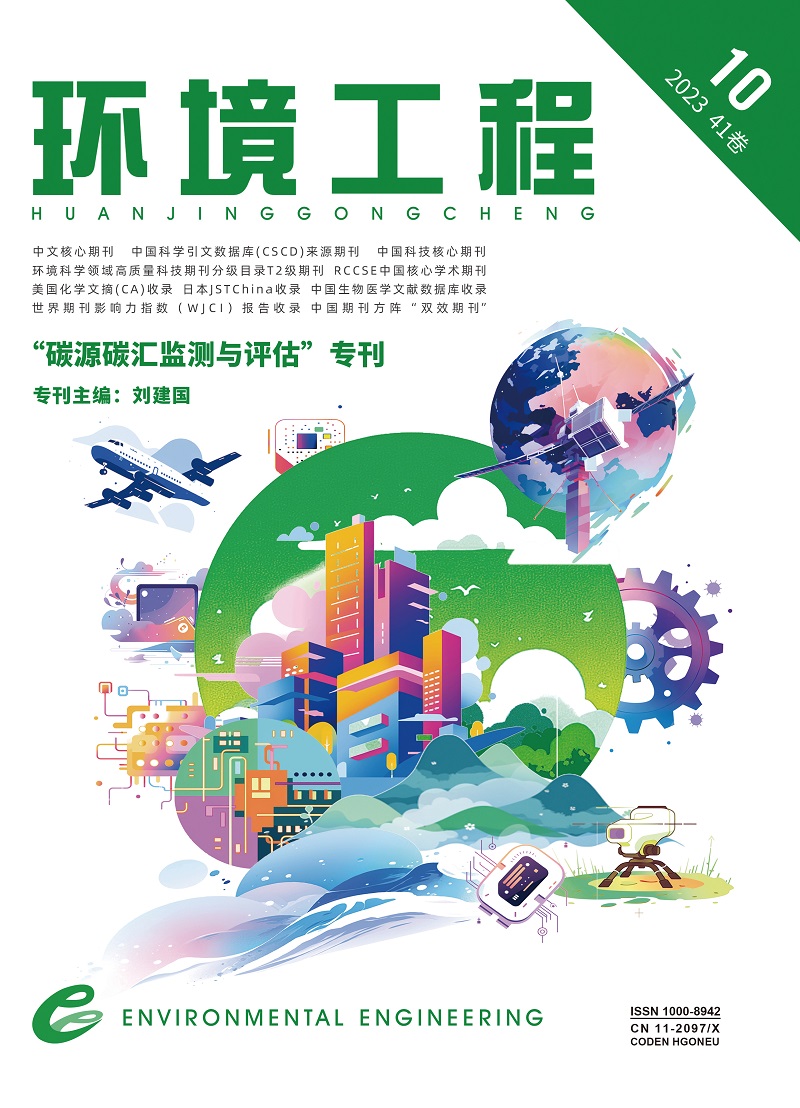| [1] |
刘华军, 刘传明, 陈明华.中国工业CO2排放的行业间传导网络及协同减排[J].中国人口·资源与环境, 2016, 26(4):90-99.
|
| [2] |
许光清, 邓旭, 陈晓玉.制造业转型升级与经济高质量发展:基于全要素能源效率的研究[J].经济理论与经济管理, 2020, 360(12):100-110.
|
| [3] |
王政.我国制造业增加值连续12年世界第一[N].人民日报, 2022-03-10(01).
|
| [4] |
ZHANG Y, CHEN X, WU Y, et al.The Environmental Kuznets Curve of CO2 emissions in the manufacturing and construction industries:a global empirical analysis[J].Environmental Impact Assessment Review, 2019, 79:106303.
|
| [5] |
XU B, LIN B.Reducing CO2 emissions in China's manufacturing industry:evidence from nonparametric additive regression models[J].Energy, 2016, 101:161-173.
|
| [6] |
傅京燕, 张春军.国际贸易、碳泄漏与制造业CO2排放[J].中国人口·资源与环境, 2014, 24(3):13-18.
|
| [7] |
张明志.我国制造业细分行业的碳排放测算:兼论EKC在制造业的存在性[J].软科学, 2015, 29(9):113-116.
|
| [8] |
何小钢, 张耀辉.中国工业碳排放影响因素与CKC重组效应:基于STIRPAT模型的分行业动态面板数据实证研究[J].中国工业经济, 2012, (1):26-35.
|
| [9] |
WANG Y, ZHANG C, LU A, et al.A disaggregated analysis of the Environmental Kuznets Curve for industrial CO2 emissions in China[J].Applied Energy, 2017, 190:172-180.
|
| [10] |
张云, 韩露露, 尹筑嘉.中国对外贸易环境效应:工业行业EKC与碳泄漏实证分析[J].上海经济研究, 2019, 365(2):110-118.
|
| [11] |
田华征, 马丽.中国工业碳排放强度变化的结构因素解析[J].自然资源学报, 2020, 35(3):639-653.
|
| [12] |
WANG X, ZHANG T, NATHWANI J, et al.Environmental regulation, technology innovation, and low carbon development:revisiting the EKC Hypothesis, Porter Hypothesis, and Jevons' Paradox in China's iron & steel industry[J].Technological Forecasting and Social Change, 2022, 176:121471.
|
| [13] |
宋晓聪, 沈鹏, 谢明辉, 等.我国工业CO2排放与经济发展脱钩关系解析[J].生态经济, 2023, 39(5):28-33.
|
| [14] |
王君华, 李霞.中国工业行业经济增长与CO2排放的脱钩效应[J].经济地理, 2015, 35(5):105-110.
|
| [15] |
DONG B, MA X, ZHANG Z L, et al.Carbon emissions, the industrial structure and economic growth:evidence from heterogeneous industries in China[J].Environmental Pollution, 2020, 262:114322.
|
| [16] |
袁伟彦, 方柳莉, 罗明.中国工业碳排放驱动因素及其脱钩效应:基于时变参数C-D生产函数的分解和测算[J].资源科学, 2022, 44(7):1422-1434.
|
| [17] |
ZHOU X, ZHANG M, ZHOU M, et al.A comparative study on decoupling relationship and influence factors between China's regional economic development and industrial energy-related carbon emissions[J].Journal of Cleaner Production, 2017, 142:783-800.
|
| [18] |
YANG L, YANG Y, ZHANG X, et al.Whether China's industrial sectors make efforts to reduce CO2 emissions from production?a decomposed decoupling analysis[J].Energy, 2018(160):796-809.
|
| [19] |
刘博文, 张贤, 杨琳.基于LMDI的区域产业碳排放脱钩努力研究[J].中国人口·资源与环境, 2018, 28(4):78-86.
|
| [20] |
马晓君, 陈瑞敏, 董碧滢, 等.中国工业碳排放的因素分解与脱钩效应[J].中国环境科学, 2019, 39(8):3549-3557.
|
| [21] |
WANG Q, ZHAO M, LI R.Decoupling sectoral economic output from carbon emissions on city level:a comparative study of Beijing and Shanghai, China[J].Journal of Cleaner Production, 2019, 209:126-133.
|
| [22] |
夏勇, 钟茂初.经济发展与环境污染脱钩理论及EKC假说的关系:兼论中国地级城市的脱钩划分[J].中国人口·资源与环境, 2016, 26(10):8-16.
|
| [23] |
凌立文, 蔡超敏, 余平祥, 等.广东省经济增长与工业三废关系研究:基于数量脱钩与速度脱钩的视角[J].中国管理科学, 2016, 24(增刊1):948-954.
|
| [24] |
李炯, 陈宇光.浙江区域二氧化碳排放差异、脱钩状态与EKC检验:基于11市面板数据的分析[J].中共浙江省委党校学报, 2014, 30(2):97-105.
|
| [25] |
朱磊, 张建清.我国经济增长与区域碳排放的关系测度:基于Tapio脱钩理论和EKC假说的实证分析[J].江汉论坛, 2017, 472(10):12-16.
|
| [26] |
JIANG J, YE B, ZHOU N, et al.Decoupling analysis and Environmental Kuznets Curve modelling of provincial-level CO2 emissions and economic growth in China:a case study[J].Journal of Cleaner Production, 2019, 212:1242-1255.
|
| [27] |
SONG Y, ZHANG M, ZHOU M.Study on the decoupling relationship between CO2 emissions and economic development based on two-dimensional decoupling theory:a case between China and the United States[J].Ecological Indicators, 2019, 102:230-236.
|
| [28] |
李竞, 侯丽朋, 唐立娜.基于环境库兹涅茨曲线的我国大气污染防治重点区域环境空气质量与经济增长关系研究[J].生态学报, 2021, 41(22):8845-8859.
|
| [29] |
何伟军, 孔阳, 沈菊琴.长江经济带灰水足迹与经济增长的二维脱钩分析[J].河海大学学报(哲学社会科学版), 2022, 24(1):68-74, 111.
|
| [30] |
彭武元, 姚烺亭.中国分行业终端能源消费CO2排放分解研究[J].生态经济, 2021, 37(8):21-27.
|
| [31] |
宋府霖, 韩传峰, 滕敏敏.长三角地区能源消费碳排放驱动因素分析及优化策略[J].生态经济, 2022, 38(4):21-28.
|
| [32] |
WANG Q, WANG S.Decoupling economic growth from carbon emissions growth in the United States:the role of research and development[J].Journal of Cleaner Production, 2019(234):702-713.
|
| [33] |
LIU Z, GUAN D, WEI W, et al.Reduced carbon emission estimates from fossil fuel combustion and cement production in China[J].Nature, 2015, 524(7565):335-38.
|
| [34] |
王家庭, 李艳旭, 马洪福, 等.中国制造业劳动生产率增长动能转换:资本驱动还是技术驱动[J].中国工业经济, 2019, (5):99-117.
|
| [35] |
张友国.疫情对中国碳脱钩进程的潜在影响:基于动态CGE模型的分析[J].中国软科学, 2021, 368(8):19-29.
|
| [36] |
曹广喜, 刘禹乔, 周洋, 等.中国制造业发展与碳排放脱钩的空间计量研究:四大经济区分析[J].科技管理研究, 2015, 35(21):224-228.
|
| [37] |
JIN B, HAN Y.Influencing factors and decoupling analysis of carbon emissions in China's manufacturing industry[J].Environmental Science and Pollution Research, 2021, 28(45):64719-64738.
|
| [38] |
HANG Y, WANG Q, ZHOU D, et al.Factors influencing the progress in decoupling economic growth from carbon dioxide emissions in China's manufacturing industry[J].Resources, Conservation and Recycling, 2019, 146:77-88.
|
| [39] |
宋晓聪, 杜帅, 沈鹏, 等.中国制造业CO2排放与经济脱钩关系解析[J].环境科学与技术, 2022, 45(7):201-208.
|
| [40] |
杜强, 张诗青, 张智慧.建筑业碳排放与经济增长脱钩及影响因素研究:以陕西省为例[J].环境工程, 2016, 34(4):172-176.
|
| [41] |
杜强, 冯新宇, 孙强.市域建筑业碳排放与经济发展关系及影响因素研究:以西安市为例[J].环境工程, 2017, 35(2):174-179.
|


 Login
Login Register
Register E-alert
E-alert






 DownLoad:
DownLoad: